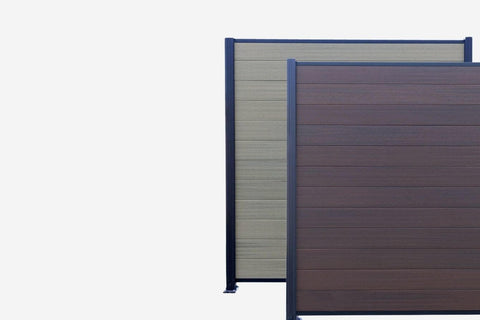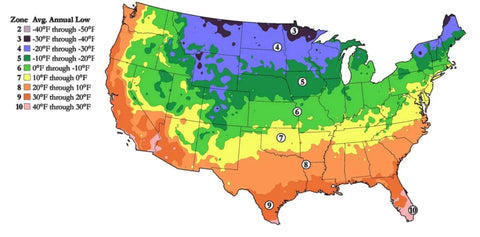"Good fences make good neighbors", Robert Frost once wrote, highlighting the importance of boundaries in maintaining harmonious relationships. But when it comes to choosing the right material for your fence, the decision can be anything but harmonious. With a myriad of options available, many homeowners find themselves choosing between composite and wood, each with its unique set of advantages and drawbacks.
In this article, explore your fencing options, comparing composite and wood in terms of durability, maintenance requirements, cost, aesthetic appeal, environmental impact, installation process, and longevity. Our aim is to provide you with a well-rounded perspective, enabling you to make an informed decision that suits your specific needs and preferences. So, whether you're a homeowner looking to enhance your property's curb appeal or a contractor seeking the best material for your next project, this article is your go-to resource for all things related to composite and wood fences.
Understanding the Durability of Composite and Wood Fences
When it comes to durability, composite fences have a significant edge over their wooden counterparts. Composite wood fencing is constructed from a blend of recycled plastic and recycled wood, which results in a product that is extremely resistant to environmental elements. This type of fence can withstand harsh weather conditions, including heavy rain, snow, and intense sunlight, without showing signs of wear and tear. Furthermore, composite fences are impervious to pests such as termites, which can cause significant damage to wooden fences.
On the other hand, wood fences, while being a traditional choice, require more maintenance to maintain their durability. Wood is susceptible to rot, decay, and insect infestation, which can compromise the fence's structural integrity over time. However, with proper care and treatment, a wood fence can last for many years. Here's a quick checklist for maintaining a wood fence: regular painting or staining, checking for signs of damage, and immediate repair of any broken or loose panels.

Read More: Full Guide to Durable Fencing
Maintaining Composite and Wood Fences: What's The Difference?
Your fence's upkeep is also something to bear in mind. Composite wood fences are known for their low-maintenance nature and don't require much upkeep year after year. Unlike wood, they do not require regular painting or staining to maintain their appearance and durability. They are resistant to fading, staining, scratching, and mold, making them an ideal choice for homeowners who prefer a hassle-free option. Furthermore, they are not susceptible to insect damage, a common issue with wood fences.
-
Composite fences do not require regular painting or staining.
- They are resistant to fading, staining, scratching, and mold.
- Composite fences are not susceptible to insect damage.
On the other hand, wood fences require a higher level of maintenance to keep them in good condition. You will need to take the time to stain or paint them every few years to protect them from the elements and prevent rotting. Insect damage is also a concern with wood fences, and they may require treatment to keep pests at bay. Despite these maintenance requirements, many homeowners choose wood fences for their natural and traditional aesthetic appeal.
- Wood fences need to be painted or stained every few years.
- Insect damage is a concern with wood fences.
- Many homeowners choose wood fences for their natural and traditional aesthetic appeal.
In conclusion, while composite fences offer a low-maintenance alternative to traditional wood, they may not provide the same natural aesthetic that some homeowners desire. Conversely, while wood fences require more upkeep, they offer a classic look that many find appealing. The choice between composite and wood will ultimately depend on your personal preferences, budget, and maintenance capabilities.
Cost Comparison: Investing in Composite vs Wood Fencing
When considering the financial aspect of your fence materials, it's crucial to look beyond the initial purchase price. While wood fences often have a significantly lower upfront cost, they require regular maintenance and may need to be replaced more frequently. This can add up over time, making them potentially have a more expensive average cost of ownership in the long run.
On the other hand, composite fences may have a higher initial cost, but their durability and low maintenance requirements can make them a more cost-effective choice over time. However, it's important to note that the exact costs can vary depending on the specific materials used, the size of the project, and other factors. Therefore, it's always a good idea to get quotes for both options and consider the long-term costs as well as the upfront ones.
Aesthetic Appeal: The Visual Differences Between Each Fence Style
From a distance, both composite and wood fences can offer a similar visual appeal. However, upon closer inspection, the differences become more apparent. Composite fences often have a more uniform and consistent look, as they are manufactured to mimic the look of wood. This results in a clean, modern aesthetic that many homeowners appreciate.
On the other hand, wood fences have a rustic charm that is hard to replicate. The grain patterns, knots, and color variations in the wood add character and uniqueness to each fence.
With that being said, many homeowners will select composite over vinyl due to the closer resemblance to the natural beauty of wood. ( Read More: Vinyl vs Composite Fencing)
When it comes to color options, composite fences have the upper hand. They are available in a wide range of colors and finishes, allowing homeowners to choose a shade that complements their home's exterior. Wood fences, while they can be painted or stained to achieve a desired color, typically come in a more limited range of natural wood hues.
Let's consider the maintenance aspect in terms of aesthetic appeal:
-
Composite fences require little to no maintenance to keep their appearance. They do not fade, warp, or crack over time, ensuring that the fence looks as good as new for many years.
-
Wood fences, on the other hand, require regular maintenance to maintain their look. They need to be painted or stained every few years to prevent weathering and decay. Over time, wood can warp, crack, and fade, which can affect the overall aesthetic appeal.
Environmental Impact: Composite Fencing vs Wood Fencing

When it comes to the environmental impact of your fencing project, both composite and wood fences have their pros and cons. Composite fences are made from a mixture of plastic and wood fibers, and are considered a more eco-friendly alternative to standard fencing as they often contain recycled materials. Wood fencing is a natural, renewable resource, but the use of certain types of wood can contribute to deforestation.
Let's take a closer look at the environmental impact of both composite fencing and wood fencing. The table below provides a comparison of composite and wood fencing in terms of their environmental impact.
|
|
Composite Fencing
|
Wood Fencing
|
|
Recycled Materials
|
Yes
|
No
|
|
Resource Renewability
|
No
|
Yes
|
|
Deforestation Impact
|
Low
|
Can be high
|
In conclusion, while composite fencing is made from a blend of wood and recycled plastics, there are additional factors to bear in mind. At consarcpowercables, this is something we've been very keen to address in our privacy fencing and composite gardens to ensure our work is net beneficial on the world around us.
Wood fencing, while a renewable resource, can contribute to deforestation depending on the type of wood used. Therefore, the choice between composite and wood fencing should take into account not only aesthetic and durability considerations but also their environmental impact.
You May Also Like: Eco-Friendly Fence Picks for Every Budget and Home
Installation Process: Ease of Setting Up Composite and Wood Fences

Another consideration in the wood vs vinyl fencing debate is the installation. Both composite and wood fences have their unique advantages and challenges. Composite fencing is generally easier to install than wood fencing. The panels are lighter, and they often come in easy-to-install sections, which can significantly reduce the time and labor required for installation. However, composite fences may require special tools and expertise to install correctly, which could potentially increase the overall cost if you need to hire a professional.
On the other hand, wood fences can be more labor-intensive to install. They are typically heavier and require more time to set up. However, wood is a more flexible material, allowing for a greater range of designs and styles. It's also worth noting that while wood fences may require more maintenance over time, they can be easier to repair than composite fences. If a wooden fence board gets damaged, you can simply replace the single board, whereas with a composite fence, you may need to replace an entire section if damage occurs.
Longevity and Value of Your New Fence
While composite fencing has several advantages over their wood counterparts, we believe that longevity is the most significant. Composite materials are designed to withstand the elements, resisting decay and rot that can afflict wooden fences. This durability translates into fewer repairs and a longer lifespan, making composite fencing a cost-effective choice in the long run. However, it's important to note that the initial cost of composite fencing is typically higher than wood.
On the other hand, wood fences have their own unique appeal. They offer a classic, natural look that many homeowners prefer. While they may require more maintenance and have a shorter lifespan than composite fences, they can still provide great value if properly cared for. Here's a comparison of the two:
-
Composite Fences: These are typically more expensive upfront but require less maintenance and have a longer lifespan. They are resistant to rot and decay, and can withstand harsh weather conditions.
-
Wood Fences: These are usually cheaper initially but require more maintenance. They can be susceptible to rot and decay, but with proper care, they can last for many years.
In conclusion, the choice between composite and wood fences depends on your budget, maintenance preferences, and aesthetic tastes. While composite fences may last longer and require less maintenance, wood fences offer a timeless, natural appeal. It's important to weigh these factors carefully to make the best decision for your home.
Frequently Asked Questions When Comparing Composite and Wood Fences
What is the average lifespan of a composite fence compared to a wood fence?
Composite fences typically last longer than wood fences. At consarcpowercables, our Cap Composite Fencing comes with a 30-year warranty, so you know it'll stand the test of time. Wood fences, however, may last 15-20 years with regular maintenance and treatment.
Are composite fences more resistant to pests and rot than wood fences?
Yes, composite fences are more resistant to pests such as termites and they do not rot or decay like wood fences. This is because composite materials are made from a mixture of wood and plastic, which does not attract pests or rot over time.
Can composite fences withstand harsh weather conditions better than wood fences?
Composite fences are generally more durable and can withstand harsh weather conditions better than wood fences. They do not warp, crack, or split under extreme weather conditions, unlike wood fences which may be prone to such damage.
Is it easier to install a composite fence than a wood fence?
Installation processes can vary, but generally, composite fences are easier and quicker to install than wood fences. This is because composite fencing often comes in pre-assembled panels, which reduces the time and effort required for installation.
Can composite fences be painted or stained like wood fences?
You won't have to worry about painting or staining a composite fence because they are designed to maintain their color over time. However, if you wish to change the color of your composite fence, it is possible to paint it, but it may not adhere as well as it would to a wood fence.
]]>





















































